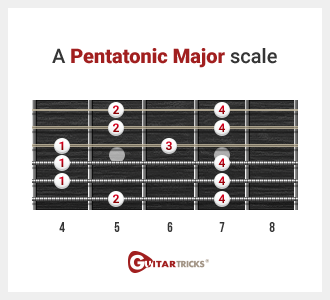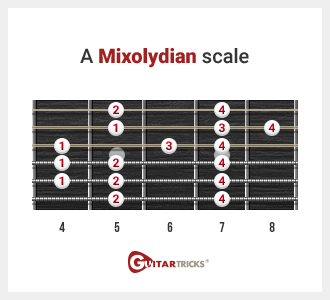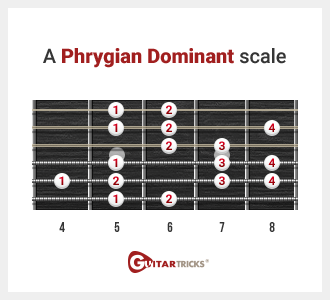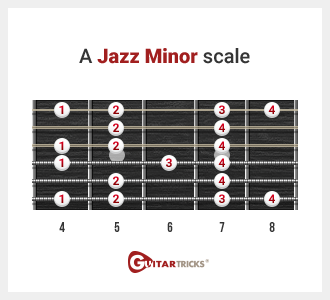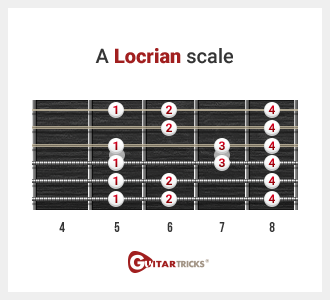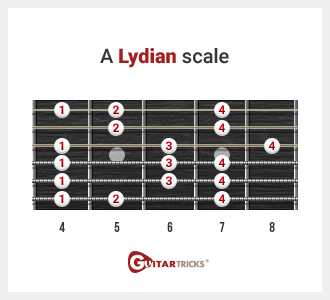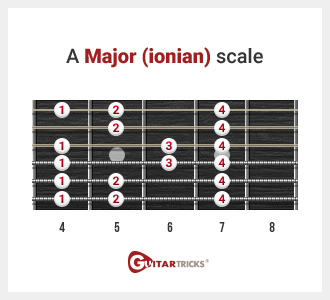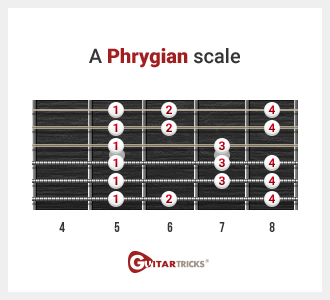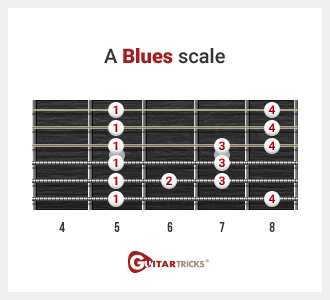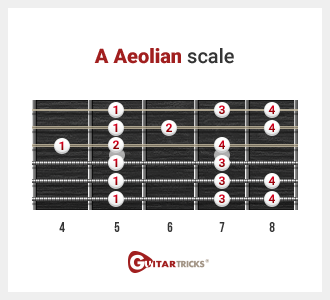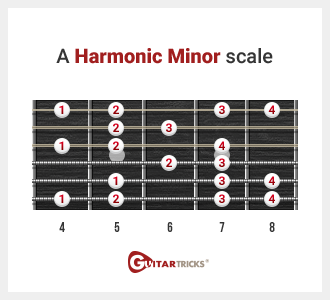Guitar Scales
Scales are the gateway to playing licks, riffs, and solos on guitar. So what is a scale?
Here's a simple definition: a succession of notes played in a certain key determined by its root note.
The foundations of the most famous guitar solos of all time lay in the use of guitar scales. Learning a few or learning the entire list below will certainly improve your technique with guitar and turn you into a shredding superstar. For the nature of this article, we will illustrate all the scales in the key of A. Let’s get started!
-
The Minor Pentatonic Scale – the grand master of all scales – learning this scale will help lay the foundations for your career as soloist. The minor pentatonic scale has only five notes to memorize, which is why it’s called a “penta” tonic scale. It’s easy to remember thanks to its box pattern and it’s moveable up and down the neck, making it extremely versatile for soloing in different keys. Comprised of the 1st, 3rd, 4th, 5th, and 7th degrees, the minor pentatonic is quite similar to the natural minor scale, but it removes the 2nd and 6th, leaving only those five versatile notes.
Here’s what a Minor Pentatonic scale looks like:
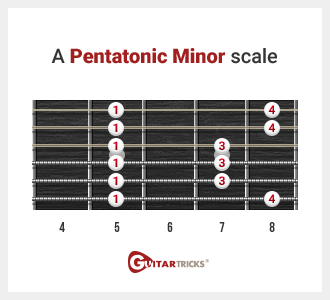
Minor Pentatonic Scale Lesson:
- The Major Pentatonic Scale – the other grand master of all scales, but it’s a major scale as opposed to minor. Just like the minor pentatonic, the major pentatonic scale consists of just 5 notes. However, instead of containing two flattened notes, it features a simpler arrangement of whole notes. You can shift a pentatonic scale from major to minor by simply move the minor pentatonic pattern down three half steps. Consisting of the 1st, 2nd, 3rd, 5th, and 6th degrees, the major pentatonic is like a normal major scale minus the 4th and 7th. Here’s what a Major Pentatonic scale looks like:
- The Mixolydian Scale - a major scale with a flatted 7th note! Wildly used in a variety of popular music from The Beatles to Iron Maiden. In it's simplest form, the mixolydian mode is a major scale with a flatted 7th instead of a major 7th. It comes in handy when you are playing over the 5th of a chord, as the mixolydian mode is considered to be the “5th mode” of the major scale and helps create tension in your playing. The Mixolydian scale is often also called a Dominant Scale due to it being derived from the 5th degree of the major scale, which is also called the dominant. Here’s what a Mixolydian scale looks like:
- Phrygian Dominant – a bonus scale I discovered on the internet a few years back, this one speaks for itself if you are hoping to tap a Spanish style vibe. The Phrygian Dominant Scale (1, b2, 3, 4, 5, b6, b7) is based on the 5th mode of the Harmonic Minor scale. If you’re already familiar with the various modes based on the major scale, it can be thought of as a Phrygian scale (1, b2, b3, 4, 5, b6, b7) with a raised 3rd. It is also commonly referred to as the Spanish Phrygian scale. Here’s what a Phrygian Dominant scale looks like:
- Jazz Minor – a major scale with a lowered 3rd degree for great jazz improv. It rises and resolves for all your weird 7th chord users out there. The “Jazz Minor” AKA the Melodic Minor Scale (1, 2, b3, 4, 5, 6, 7) is simply a minor scale with a natural 6th and 7th. It can also be easily remembered as a major scale pattern with a b3. Spelled out, it contains E, F#, G, A, B, C# D# The triads built upon these notes form the chords Emin, F#min, Gaug, A, B, C#dim, D#dim. Here’s what a Jazz Minor scale looks like:
- Locrian – this scale sharpens the second and third notes of the diatonic Locrian mode. This scale doesn’t resolve as well as others mentioned here and is not used much in Western music. Still, it’s good to know for expanding your scale vocabulary. Considered the 7th mode of the major scale, the Locrian scale has a pretty specific sound due to its use of b2, b3, b5, b6 and b7 — hence it is not as widely used as some of the aforementioned scales. The Locrian scale is one of four minor modes -- among Dorian, Aeolian, and Phrygian – and is the only mode to contain a diminished 5th. Here’s what a Locrian scale looks like:
- Lydian – the iconic Frank Zappa made a lot of us of this scale. For more contemporary music, check out Grizzly Bear’s “Two Weeks.” The 4th mode of the major scale, the Lydian scale contains an augmented 4th note, which is raised by one half step, giving the scale a brighter sound than a normal major scale. This is the only element that differentiates the Lydian scale from the Ionian (or Major) scale. Songs that employ the Lydian mode usually have a joyous, bright nature due to the scale’s “super major” sound. Here’s what a Lydian scale looks like:
- Major (Ionian) – with its dissonant major sound, the major Ionian is a great way to take your soloing to the next level. If you think you haven’t heard of the Ionian scale, I promise: you have, you just don’t know it. One of the world’s most common scales, the major (or Ionian) scale is generally the first scale learned by beginner guitarists (or any instrumentalists for that matter). The proper formula of whole vs half steps for the major (Ionian) scale would be W-W-H-W-W-W-H (an easy way to remember this is to think about the “Do-Re-Mi” song from The Sound of Music). Here’s what a Major (Ionian) scale looks like:
- Phrygian – this is a minor mode that appears with a bII. It is very hard to capture this scale in modern music as a song can start off with a Phrygian vibe but change into another mode completely! Commonly understood as sounding slightly “Egyptian,” the Phrygian scale is fairly unusual, in that while it is a mode of the major scale, it is more so a form of minor scale due to its third note being a minor third above the scale’s tonic note. It also contains a minor 6th, 7th and 2nd. This amount of flattened notes gives the Phrygian scale a seriously dark sound. The Phrygian Dominant scale mentioned previously raises the 3rd from minor to major, giving it a slightly brighter sound and making it a go-to for flamenco music. Here’s what a Phrygian scale looks like:
-
Super Locrian – this altered scale is perfect for jazz-rock fusion & jazz improv. Try playing it over altered dominant 7 chords. With a dominant 7 arpeggio and four alterations, the Super Locrian scale creates a massive amount of dissonance and when used (and resolved) correctly it can give your playing — especially jazz and blues — an incredible sense of tension and resolution.
Here’s what a Super Locrian scale looks like:
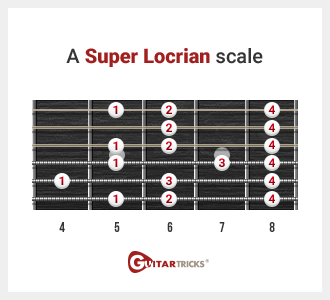
-
Whole Tone – no semitones to be found here. Only whole tones separate this scale from scales like chromatic ones, which consist entirely of half steps (or semi-tones). Also known as a symmetrical scale, a Whole Tone scale actually only contains six notes. The Whole Tone scale is probably among the most rare in actual music, appearing mostly in harmonies used by impressionist composers like Debussy and jazz/improvisational composers like Thelonious Monk.
Here’s what a Whole Tone scale looks like:
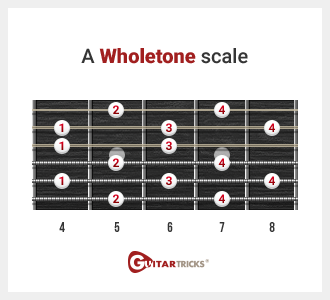
- Blues Scale – need a different scale for your blues solo? Look no further! The collection of notes that people refer to as “the Blues Scale” is really just a pentatonic scale with one note added. Also known as the “Pentablues” scale, this scale adds a flat fifth if you’re playing a minor pentatonic scale, or a flat third if you’re playing a major pentatonic scale. Here’s what a Blues Scale looks like:
- Dorian – very popular in jazz, the Dorian mode is also at home in rock and metal for added complexity. Daft Punk’s “Get Lucky” also utilizes this unique mode! The second out of seven total modes of the major scale, the Dorian is considered a minor mode due to its flattened 3rd and 7th. These minor intervals make it a fairly dark-sounding scale, however it does still have a brightness to it that other minor scales often lack. Here’s what a Dorian Scale looks like:
- Aeolian – this musical mode is the natural minor scale. Famous songs include Fleetwood Mac’s “Rhiannon” and “Sweet Dreams” by the Eurythmics. Likely the scale you hear the most often besides the Major (Ionian) scale, the Aeolian scale --being the natural minor — consists of the root, major second, minor third, perfect fourth, perfect fifth, minor sixth and minor seventh. This makes it just about the same as the previous Dorian mode with the addition of the minor sixth. Here’s what an Aeolian Scale looks like:
-
Harmonic Minor – another natural minor scale but the 7th note is raised one semitone both ascending and descending. The talented guys in Muse use this mode a lot but it’s important to know that many songs using this scale don’t often resolve in the same scale. Quite similar to the natural minor, the Harmonic Minor scale raises that 7th just a half step, leading it to also be known as the “Aeolian #7” scale. This raised 7th is also referred to as a “leading tone” and gives the scale a unique sound. It can be a bit awkward to properly use the Harmonic Minor scale, but when used effectively, it can be a great tool for soloing over riffs or arrangements that use a V7 chord resolving in a minor chord.
Some wildly popular songs (including a few you may not expect) that employ the Harmonic Minor effectively include No Doubt’s “Don’t Speak”, Cat Stevens’ “Wild World” and “California Dreamin” by The Mamas and the Papas. Coolio’s “Gangsta’s Paradise” even features a Harmonic Minor scale. Here’s what a Harmonic Minor scale looks like:
How To Practice Guitar Scales
Start slowly and use a metronome. Work on getting these scales under your fingers
comfortably at three tempos; slow, medium, and fast. Work on them ascending and
descending, and walk them up the neck fret by fret.
Once you get a couple scales under your hands at a slower tempo, you can start
having fun with it! Play around with the notes in the scale and try to come up with
some melodies and riffs. Try playing some scales over some jam tracks and get a
better feel for how playing solos and melodies works. The more you do this, even at
slow tempos, the easier it will get.
You will probably notice that working through scales, you’ll start seeing how chords
are built.
Scale practice might not be the most romantic part of playing the guitar. Scales are
the building blocks of playing guitar and of music. But once you get these under
your hands, one scale at a time, you’ll be that much closer to rock legend status.
Need more scales? Check out our handy Scale Finder for even more scale positioning!
Guitar Tricks Scale Finder
